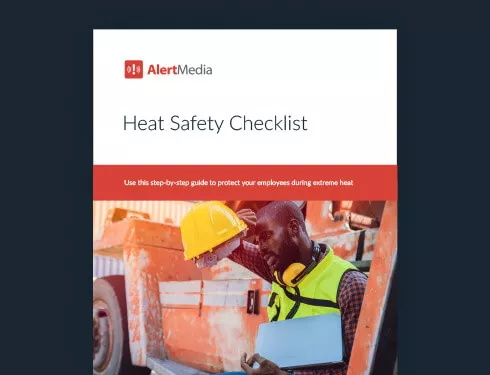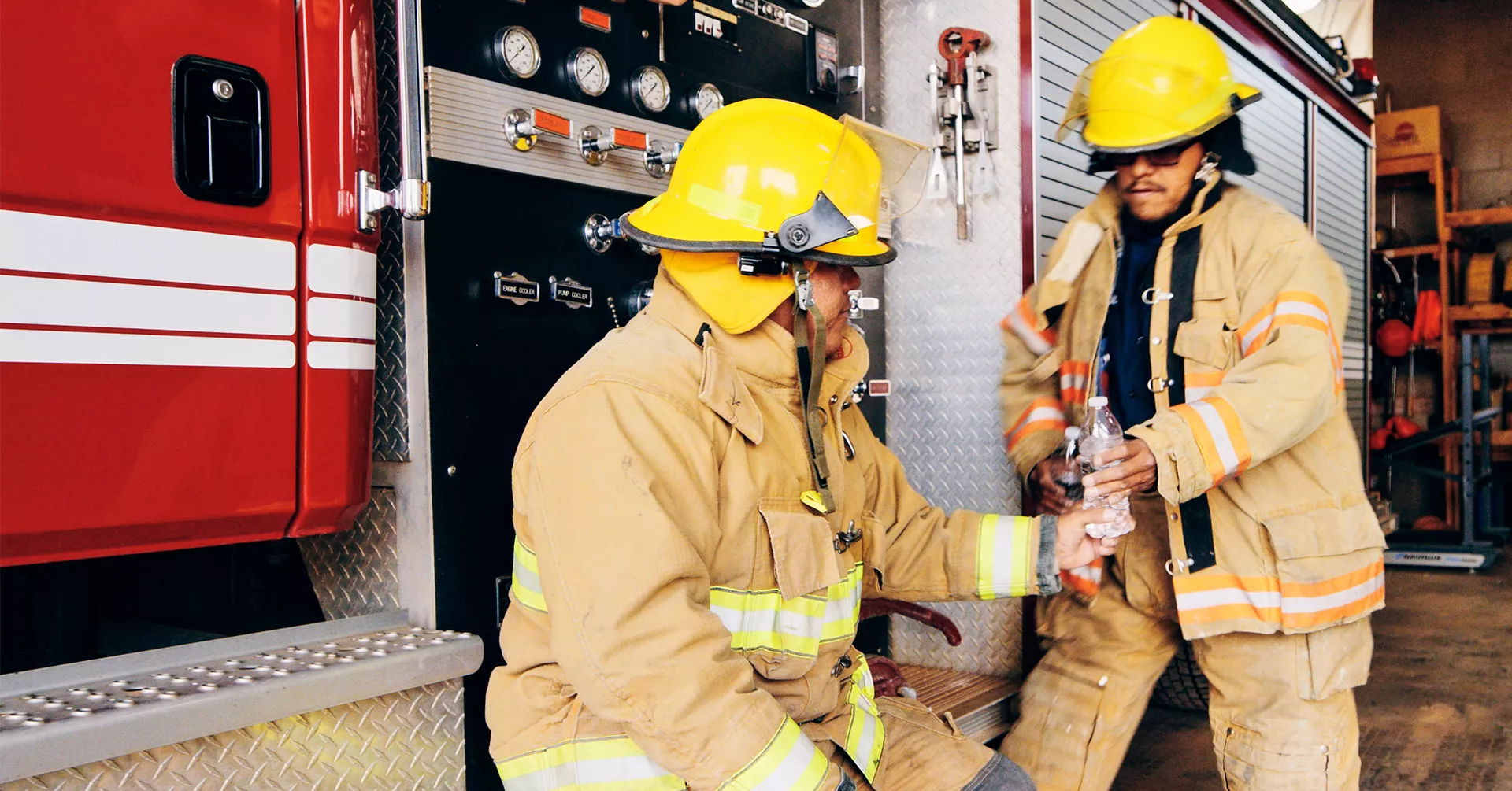
What Are the New OSHA Heat Regulations? + How to Prepare
The recent release of the upcoming OSHA heat regulations gives us a better idea of what will soon be required around heat safety at work. Learn all about how to stay heat-safe and OSHA-compliant.

Heat safety is getting closer to a formal OSHA standard, with the agency recently releasing the unofficial version of their proposed Heat Injury and Illness Prevention in Outdoor and Indoor Work Settings rule.
But while we wait for the official version to pass, there are still extensive requirements for how you need to protect your employees. Learn all about how to stay heat-safe and OSHA-compliant.
Heat is a top concern for all businesses, but it’s particularly important for those with employees working outside or in areas without sufficient cooling measures. Global temperatures have risen at record-breaking rates. 2023 was the warmest year on record, and 2024 has already broken many of those records in the first half of the year. Protecting your employees from the dangers of extreme heat is a growing concern that will, unfortunately, not lessen in the near future.
Paul Yura, Warning Coordination Meteorologist at the National Weather Service, talked with us on The Employee Safety Podcast all about extreme heat. “What we’re seeing [looking into the future of extreme heat] is what we’re going to get, if not worse, because of climate change,” he told us. “Businesses have to get ahead of this right now because it’s not going to reverse itself any time soon.”
Hot environments are a daily fact of life in many workplaces. Researchers found that outdoor workers in the U.S. face up to 35 times the risk of dying from heat exposure compared to the average American.
But employees in indoor work settings also risk exposure to high heat—facilities such as warehouses and factories rarely have air conditioning, and equipment like furnaces and ovens exacerbate high temperatures. This is the reason for the OSHA indoor temperature regulations included in the larger OSHA temperature regulations.
Breaking Down the New OSHA Heat Rules (+ Current Heat Regulations and Recommendations)
Heat-related stress in the workplace has high financial and health costs for both businesses and employees. Until this recent ruling proposal, they’ve relied on the General Duty Clause when issuing heat-related citations.
“Heat is a recognized hazard by OSHA, and it’s been using the General Duty Clause traditionally [to enforce safety]. It is also working on a permanent standard with more specifics as to what employers have to do. But in the meantime, OSHA has come out with a national emphasis program. It’s a three-year program in which OSHA is devoting a big part of its resources to sending its inspectors into the field and into workplaces, showing up and ensuring that employees who might be exposed to heat illness are being protected.”
—Courtney Malveaux, Co-Leader of the Workplace Safety and Health Practice Group at Jackson Lewis
But the new OSHA rules would create specific requirements around heat safety and preparedness. While the specific language is still subject to change, the new OSHA temperature regulations would apply to all outdoor workers and indoor workers where combined temperature and humidity levels rise above 80 degrees.
What will be required under the new OSHA rule?
Here are the new requirements that would be introduced when this proposal is accepted. You can read the full details and exemptions in the unofficial text of the proposal here.
- Employers must have a heat injury and illness prevention plan
- Employers must identify and monitor heat hazards
- If temperatures rise to or above threshold (80 degrees), the following controls must be implemented
- Drinking water
- Break areas with shade or air conditioning
- Fans, air conditioning, or heat exposure reduction
- Acclimatization for new or returning workers
- Rest breaks
- Effective, two-way communication with employees
- Cooling PPE
- Additional controls are implemented at the high heat trigger of 90 degrees, including:
- Additional paid rest breaks
- Mandatory observation for signs and symptoms of heat illness
- Heat hazard alerts with critical information
- Employers must develop and implement heat illness and emergency response plans
- Employers must train their employees on heat stress hazards, heat-related injuries and illnesses, including risk factors, signs, and symptoms, as well as heat safety and company-specific policies and resources. Supervisors also have specific training requirements.
- Employers must maintain accurate and comprehensive records
What these requirements mean
Illness reporting: Injuries like a broken finger are easy to identify, but heat-related illnesses vary widely in symptoms and severity. Detailed reporting—including conditions like heat stroke and heat exhaustion—will help refine the rulemaking process over time. Additionally, more extensive reporting is expected to help address the disproportionate effect of heat hazards on people of color and economically disadvantaged groups.
Prevention and training programs: Existing state regulations are a possible clue of what federal regulations will include. For example, California’s training requirements for both employees and supervisors are a potential model for what companies will need to offer in the future.
Environmental monitoring: OSHA currently recommends using wet bulb globe temperature (WBGT) devices to track workplace heat. According to the National Weather Service, WGBT measures the impact of heat in direct sunlight, taking into account temperature, humidity, wind speed, sun angle, and cloud cover. It’s a safe bet that WBGT monitoring will be a component of the upcoming regulations. Some industry groups have suggested the use of a heat index for environmental monitoring. However, OSHA has traditionally shied away from that metric because it takes into account fewer variables than WBGT monitoring.
Engineering and administrative controls: Engineering controls vary widely by setting—what applies to a bakery wouldn’t make any sense for a landscaping company. However, there are many contextual and situational engineering requirements that could end up in the final regulations based on industry, company size, and workplace circumstances. Additionally, administrative procedures are likely to be a key component of the rules.
Personal protective equipment: OSHA already regulates PPE from a variety of other safety perspectives. Extending those rules to the prevention of heat-related illnesses and fatalities is a natural fit. Certain types of PPE can also increase the risk of overheating, so regulations will likely address balancing protection from other hazards against temperature-related dangers.

These requirements will make huge advancements in protecting employees from the hazards of working in extreme heat conditions. In the meantime, there are things you can do right now to protect your employees, stay compliant with current regulations, and prepare your business for compliance under these new rules.
OSHA’s current heat requirements
OSHA points to NIOSH’s Recommended Heat Standard as guidance for heat safety standards and recently established the national emphasis program, which enables it to perform more proactive inspections of facilities.
There are also three states that have existing regulations that can be used as examples of what to do:
- California: Cal/OSHA has the most comprehensive directives for employers, including training and planning requirements.
- Minnesota: Their rules cover only indoor workplaces but set forth regulations for both hot and cold temperatures.
- Washington: Conversely, Washington’s legislation applies to employees only in outdoor settings.
California’s heat safety and heat illness prevention standards have recently been updated to include indoor heat safety as well as outdoor. According to the new standards, all indoor places of employment where the temperature reaches 82 degrees Fahrenheit or above must comply with regulations around access to water, cool-down areas, acclimatization, training, and more.

Start by Assessing Employees’ Level of Risk from Environmental Heat Stress
The release of OSHA’s heat regulations is still pending, but it’s never too soon to work on building a safer work environment. As with any work-related hazard, prevention starts with understanding your level of exposure to risks.
There are countless variables that contribute to heat-related illnesses, such as an individual’s age, health, and diet. Conditions that are dangerous for one employee might be perfectly safe for others. Balancing duty of care with business continuity is already difficult for many companies, and the complicated standards can make enforcing heat safety feel a bit uncertain. But there are plenty of other resources to turn to when creating your heat safety plan. Here are concrete steps you can take internally to identify and mitigate risks of heat-related illnesses.
Get an onsite consultation
One option for assessing your risks is to take advantage of OSHA’s voluntary onsite consultations. A specialist will visit your worksite to evaluate potential heat-related hazards and make recommendations on existing prevention and training measures.
The service is completely free and confidential, and they won’t issue any fines or citations. Your company will need to correct any serious hazards that they identify, but the consultation also qualifies you for a one-year exemption from OSHA inspections.
Teach heat hazard recognition
When discussing situational awareness in the workplace, hazards like a wet floor or dangerous chemicals are easy to identify. However, the same concepts apply to recognizing heat hazards, which can be more nuanced. Employees need to be aware of their surroundings and make decisions accordingly.
There are several key factors to monitor when assessing the dangers of extreme heat:
- Environmental factors such as air temperature, sunlight, humidity, and airflow
- Level of exertion and workload
- Clothing or PPE that impacts the body’s ability to shed heat
- Presence of excess heat sources like ovens or furnaces
Understand personal risk factors
Every employee at a worksite is subject to the same environment, but their bodies will each handle it differently. It’s critical for workers to understand the personal risk factors that can increase sensitivity to heat-related illnesses:
- Body weight, especially obesity
- Diabetes, high blood pressure, and other chronic health conditions
- General physical fitness level
- Medications that impact hydration or sweating
- Overall alcohol intake
- Illicit drugs that affect the body’s metabolism
Establish a Heat Illness Prevention Plan to Protect Employees
When it comes to heat hazards, there are a variety of risk factors to monitor, environmental conditions may change rapidly, and it can be challenging to spot early signs of illness. Building heat-related illness prevention into your workplace safety policy is integral to ensuring your employees engage in safe work practices. And building this plan now will help ease the transition when the official ruling is passed.
Here are six areas to focus on when establishing plans and protocols for heat safety.
1. Hydration and rest breaks
- Develop a mandatory break schedule and increase the frequency as the risk of heat-related illness rises
- Set up easily accessible hydration stations with enough drinking water for each employee to consume one quart per hour
- Provide sports drinks, ice pops, and hydration supplements
- Make first aid kits available throughout worksites, and regularly check that they’re fully stocked
2. Engineering controls
- Make cooling systems such as air conditioning and fans available wherever possible
- Install insulation around heat sources and use reflective shields to redirect radiant heat
- Improve ventilation and airflow wherever possible to encourage heat dissipation
- Leverage powered equipment like conveyors and forklifts to reduce employee workload and physical exertion
- At outdoor worksites, set up ample shade and misters for employees to cool off during breaks
- Use a wet bulb globe temperature device to monitor environmental conditions
3. Training
- Train all employees on precautions to take and heat safety tips to follow in hot environments as well as how to adjust to changing conditions
- Make sure workers understand the early signs of heat-related illness and set clear action plans for how to report symptoms
- Provide first aid classes, instructions on how to treat heat-related illnesses, and guidance on when to seek emergency medical care
- Discuss contingency plans for possible complications like unseasonably warm temperatures, power outages, and broken cooling systems
- Include heat hazard planning in monthly safety meetings during warmer months to serve as a refresher for employees
4. New workers and acclimatization
- Ensure new workers have clothing that is well-ventilated and allows excess body heat to dissipate
- Follow acclimatization guidelines by restricting new workers to no more than 20% of a shift at full intensity, increasing by 20% each day until they’re comfortable with the conditions
- Pair newer workers with experienced employees who can help them understand the work conditions and ease into the situation
- Train supervisors to proactively monitor new hires and ensure they’re taking frequent breaks, hydrating, and following your company’s heat policies
5. Work practices
- Create an inclement weather policy that includes contingencies for extreme heat
- When possible, schedule work during cooler parts of the day, such as early morning
- Set a maximum temperature for work as appropriate for your environmental conditions
- Rotate high-effort job functions among workers to minimize exertion and workload
- Use an employee safety monitoring platform to communicate weather conditions and give employees a way to report issues or illnesses in real time
6. Personal protective equipment
- Identify how PPE increases heat hazards and factor that into your plans to monitor conditions
- Encourage the use of reflective clothing, as well as light and loose-fitting materials
- In outdoor settings, provide sunscreen and give employees the option to wear hats as long as they don’t conflict with other PPE guidelines
- Provide cooling neck wraps and jackets or vests with built-in ice packs to help reduce body temperature
Plan Ahead to Implement OSHA Recommendations for Heat Safety
Environmental conditions are outside of your control, and for many industries, working in high temperatures is unavoidable. That’s why your company needs a heat illness prevention plan based on OSHA upcoming requirements for heat safety—to keep your business running without sacrificing your employees’ well-being.
Given the increasing risk and high cost of heat-related incidents to your business and your people, the anticipation for OSHA’s new regulations is palpable. The forthcoming regulations will help shape and refine your heat illness prevention plan, but starting the process now gives you a head start. Whether you’re starting from scratch or refining existing heat hazard policies, your employees’ health and safety depend on robust prevention, training, and response plans.
With proper foresight, your employees can stay cool on even the hottest days and happily return to the comfort of their air-conditioned homes after a hard day’s work.





